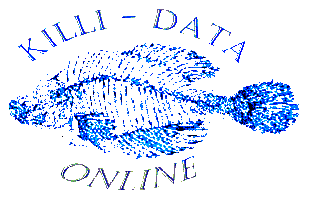SAMPLE CONTENT OF THE DATABASE
Killi-Data online basically provides most available information for a selected taxon, on a taxon by taxon basis.
![]() Beware, the Google automatic translator reverses scientific names.
Beware, the Google automatic translator reverses scientific names.
In database, you will have first to select a taxon from an alphabetical list, containing names of :
- genera or subgenera in full, whenever presumably valid today or not:
e.g., Aphanius or (synonym) Aphaniops. - species or subspecies in full, whenever presumably valid today or not, followed by the abbreviation of the herein currently recognized genus:
e.g., chauchei A., for Aphyosemion chauchei
or (subspecies) fasciolatus Ep., for Epiplatys fasciolatus fasciolatus
or (synonym) dorni K., for Kryptolebias dorni.
- besides, additional data and lists, lacking or not in the books, are now all included in database :
- a pyramidal list according to family-group names
- a genera and subgenera menu
- a species list according to conservation status
- a list of valid species by countries
- a list of collecting localities by country
- a list of specific and generic names by describers
- a list of all valid species by major morphomeristics
- a list of all valid species by genetic characteristics
- a list by types of systematic evaluations
- a list of all valid species by ethological characters
- a list of all valid species by landscape characteristics
- a list of all valid species by ecological data
- a list of all valid species by major aquariology data
- a list by aquarium populations
- a list by photos for each superspecies or species group
- a list by origin of type specimens in scientific institutions
- a list of links for direct access to recently described species and genera
- an alert system for newest publications
- a series of links to all Killiflash for each year (since 1961) and direct access by each name of author(s) of publications
- a list of recent minor changes and major systematic and nomenclatural updates
- several lists of main statistics of the database
- and free access to services such as Killi-Data Series scientific yearly journal, Killi-Data Wassup news magazine, some collecting trip reports
All legends and explanations of headlines are given below in the sample page. To read first these important notes, click HERE.
ALL FILES OF THE DATA BASE ARE TREATED IDENTICALLY AS THE HEREAFTER SAMPLE
Complete example, as a sample, of the file of chauchei A. (for Aphyosemion chauchei, to acknowledge Maurice Chauche' s friendly cooperation over so many years), as it used to be on screen in 2001 (today it is not different in structure, but obviously data have been strongly updated).
Reversed name: chauchei A.
Major revision edition update: January 1. 2001. Copyright: Huber, Killi-Data International, www.killi-data.org.
Aphyosemion chauchei
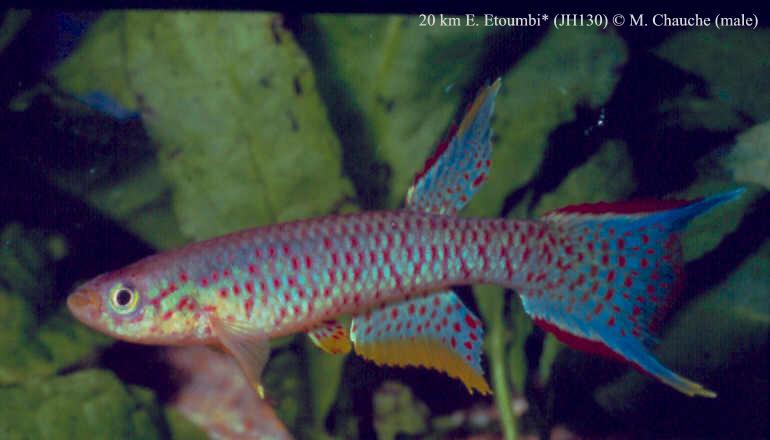
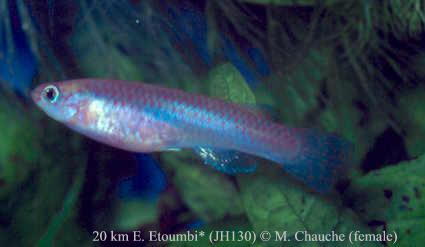
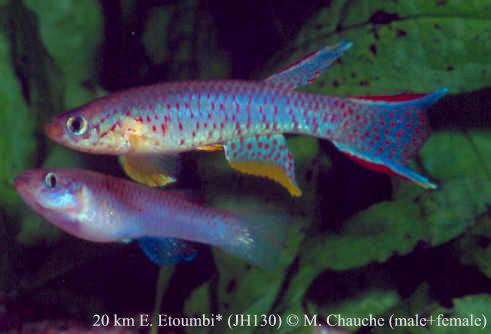
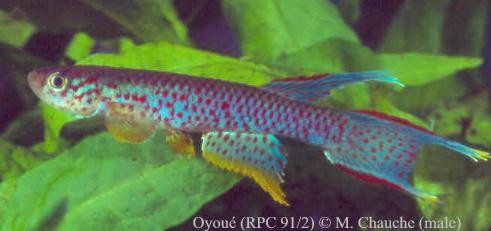
CURRENT NAME: Aphyosemion chauchei
describer(s), year: Huber & Scheel, 1981
IDENTITY: chauchei A.
Family: Nothobranchiidae Garman, 1895
Subfamily: Nothobranchiinae Garman, 1895
Tribe: Nothobranchiini Garman, 1895
Subtribe: Aphyosemiina Huber, 2000
Genus: Aphyosemion
Subgenus: (Aphyosemion)
Abbreviated genus: A.
Abbreviated subgenus: (A.)
Species: chauchei
Index name: chauchei: Aphyosemion chauchei
Full name: Aphyosemion (Aphyosemion) chauchei
Abbreviated extended name: A. (A.) chauchei
Abbreviated short name: A. chauchei
TYPOLOGY: chauchei A.
Original name: Aphyosemion chauchei
Describer(s): Huber & Scheel,
Year of description: 1981
Type locality: 20 km east of Etoumbi towards Makoua, central Congo.
Types series: Holotype: MNHN {Paris} 1981-628 (male, 20.0 mm S.L.). Paratypes: MNHN 1981-629 (3).
Discoverer(s): Jean H. Huber, July 1980.
Etymology: in honor of Maurice Chauche, Saint Ouen, near Paris, French aquarist, fish photographer and friend of one of the describers.
Gender/Accordance: [Name]
SYSTEMATICS: chauchei A.
Current status: valid sp.
Misspelling(s): (chachei = erratum)
CURRENT SYNONYMS: [original name(s) with availability status]
None.
RESEARCH: chauchei A.
Status evaluation (current): confirmed by several authors.
Systematic remarks: well defined.
Miscellaneous comments: a forest blue counterpart of schioetzi.
Superspecies components: castaneum, chauchei, christyi, cognatum, congicum, decorsei, elegans, ferranti, lamberti, lefiniense, lujae, musafirii, plagitaenium, polli, pseudoelegans, rectogoense, schioetzi, schoutedeni.
Diagnosis: orange marginal broad zone in Anal fin and red, vertically oblong, numerous spots on blue sides and inner fins of male (the blue counterpart phase of schioetzi).
Future research: new collecting localities, distribution evaluation, detailed aquarium observations, crossing with other components, notably lamberti and schioetzi, variability, detailed osteology, molecular analysis.
Historical milestones of knowledge: Huber & Scheel, 1981 : short morpho-description in genus Aphyosemion within a systematic and karyotypic revision of the elegans superspecies, diagnosed from related components and notably the other blue phase lamberti, by yellow orange inner coloration at male Anal fin.
DISTRIBUTION AND ECOLOGY: chauchei A.
Countries of distribution: Congo
Range: small, in northwestern forested plateau of Congo.
Biogeographically replaced: northerly by elegans, westerly by lamberti, southerly by schioetzi, easterly by the components of the cuvette (christyi-like, decorsei-like).
Sympatric taxa: Ep. phoeniceps, Hyl. stictopleuron.
Availability in nature (conservation status): widespread.
Typical landscape: plateau.
Biotope coverage: primary forest.
Niche: marigots.
Subniche preference: deadly water on darker and dirty substratum (dead leaves, mulm).
Depth of water (low): about 30 cm.
Flow speed (low): slow current.
Water chemistry: acid freshwater.
Temperature of water: 20°C-30°C.
Position in water: top layer.
Social behavior: passive tribes.
Intraspecific behavior: competitive.
Breeding behavior: laying egg on aquatic plants and roots.
Food (dominant): ants and other insects.
AQUARIUM RECORDS: chauchei A.
First breeding aquarium record: France (Maurice Chauche), 1978.
Aquarium set-up: pair, 20 litres, half-filled, dead leaves/sand, short top mop, Java moss, smooth filtering, diffused light.
Difficulty of breeding: experienced.
Life cycle: non-annual.
Egg diameter: 1.2 mm, with streaks, adhesive.
Incubation lag: 2 weeks.
First food: artemias (nauplies).
First swimming: immediate, anywhere in water.
Sexation in aquarium: 8 weeks.
Maturity in aquarium: 6 months.
Lifespan in aquarium: 3 years.
Availability in aquariums: rare.
Aquarium populations: Obeya, Oltombo, Oyoué
KEY MORPHO-MERISTICS: chauchei A.
Max. size of male (cm): 5
Female body size (vs. male): smaller.
Dorsal rays (average, male only if dimorphic): 10
Anal rays (average, male only if dimorphic): 16
D/A deviation (average, male only if dimorphic): 10
LL scale count (average): 30
Predorsal length (% S.L.) (average, male only if dimorphic): 66%
Depth (% S.L.) (average, male only if dimorphic): 20%
Vertebrae count (average): 28
COLOR PATTERN: chauchei A.
Overall melanism on body: with no or little melanistic markings.
Markings, on mouth: no or irregular markings (a lower orange tinge in dominant male, like in Anal fin).
Markings, surrounding eyes: no distinctive ornament.
Coloration on iris: no ornament.
Markings on back: none, specific.
Markings on belly: none, specific.
Preopercular colored markings: reduced oblique red lines (shield).
Preopercular temporary dark markings: none.
Postopercular temporary dark markings: none.
Sides longitudinal temporary dark markings: none.
Sides vertical temporary dark markings: none.
Metallic shining on sides: none.
Structure of pattern on male sides: irregular but organized (derived).
Male dominant background color: blue/green, with red markings.
Male color on mating: similar.
Female color on mating: similar.
Overall body dichromatism: female, faint and poorly marked.
Supracaudal ocellus: no.
Type of markings on male mid-anterior sides: irregular spots or speckles.
Type of markings on male posterior sides: irregular spots or speckles.
Posterior pattern compared to anterior, in male: similar.
Upper sides and back color pattern: nothing characteristic.
Pectoral fins, in male: colored (orange) without margin.
Ventral fins, in male: irregularly marked, innerly (with orange color in dominant male).
Paired fins in female, compared to male: unmarked and translucent.
Dorsal fin border pattern, in male: a red margin, only (sometimes thinly underlined with orange).
Dorsal fin inner pattern, in male: with irregular dots.
Dorsal fin base pattern, in male: irregular dots.
Anal fin border pattern, in male: a broad orange margin.
Anal fin inner pattern, in male: with irregular dots.
Anal fin base pattern, in male: irregular dots.
Dorsal fin pattern compared to Anal fin: dissimilar, but derived.
Caudal fin upper border pattern, in male: a red margin, only.
Caudal fin lower border pattern, in male: a red margin, only.
Caudal fin inner pattern, in male: with irregular dots.
Caudal fin posterior pattern, in male: no specific marking.
Caudal fin upper region compared to lower, in male: symmetrically similar (mirrored).
Caudal fin pattern, compared to Dorsal and Anal, in male: similar to Dorsal fin, only.
Male color extensions, compared to their marginal base: similarly colored.
Female unpaired fins: Dorsal fin only, with markings.
Female unpaired fins pattern, compared to male: different and translucent.
Other pattern characters: first ray of Dorsal and Anal, white, in dominant male; some pale blue iridescent dots, lowerly, on sides of dominant male.
Preserved pattern specificities: male and female, peppered with dark dots on sides and inner fins.
BODY MORPHOLOGY (superspecies-derived, except specificities): chauchei A.
Body dimorphism (sexual): none (or little).
Allometry in body growth: no or little allometry.
Vertical profile of body: spindled (greatest depth 25% more than peduncle).
Transversal profile of body: moderately compressed (backwards from vent opening).
Greatest body depth in male: well before Ventrals insertion.
Vertical anterior profile of head: somewhat depressed, with a low lower angle.
Upper and lower jaws profile: shortened above and rounded below.
Orientation of mouth opening: upwards oriented.
Level of mouth opening, vs. opercular depth: high (at about a quarter of depth).
Eye vertical position, vs. opercular depth: high (at about a quarter of depth).
Interorbitar vs. depth at eye level: enlarged (15% to 30% larger).
Eye level, vs. mouth: eye center, at level of mouth opening.
Eye diameter: standard (about snout length).
Opercular depth: lower than head length.
Opercular upper profile in dominant male: a continuous curve.
Opercular lower profile in dominant male: no extension.
Transversal upper outline of head: flat front and convex predorsum.
Upper vertical outline of head and nearby: smooth curve, overall.
Lower vertical outline of head, around opercle: slightly bent line.
Upper outline of body: slightly bent and continuous dorsal line.
Lower outline of body: slightly bent and continuous anal line.
Back vs. belly outline, in male: symmetrical.
Prepeduncular outline of body: straight lines.
Peduncular depth, relative to head depth: about equal to head depth, at eye level.
Peduncular and Caudal fin outline: with an upper and lower disruption.
FIN MORPHOLOGY (superspecies-derived, except specificities): chauchei A.
Pectoral fins insertion: very low, close to lower body outline.
Pectoral fins shape, in male: rounded and short.
Pectoral fins posterior profile, in male: curved.
Ventral fins insertion: closer to Anal fin insertion.
Ventral fins shape, in dominant male: longer and reaching Anal fin insertion.
Ventral fins posterior profile, in male: curved.
Pectoral fins dimorphism (sexual): none (or little).
Ventral fins dimorphism (sexual): weak, in fin length.
Dorsal fin anterior border: with a disruption, close to insertion (low fin).
Dorsal fin superior border, in male: straight, slightly divergent from body outline (trapezoid).
Dorsal fin, position of apex in male: posterior rays, longest.
Dorsal fin, shape of apex in male: pointed.
Dorsal fin corner in male: extended.
Dorsal fin, posterior border in male: straight, at least dominantly.
Dorsal fin posterior border vs. anterior, in male: twice longer.
Dorsal fin, insertion in male (tendency): backwards, with a high predorsal length (about 2/3rd S.L.).
Dorsal fin, deviation to Anal (D/A) in male: backwards, closer to Anal ending (usually D/A= +7 to +10).
Dorsal fin shape, compared to Anal fin in male: symmetrically similar.
Dorsal fin shape, in male vs. female: similar, but extended and pointed.
Dorsal and Anal meristics, male vs. female: no or little dimorphism.
Dorsal fin shape, vs. Anal in female: symmetrically similar (rounded and equally deep).
Anal fin shape, in male vs. female: similar, but extended and pointed.
Anal fin anterior border, in male: with a disruption, close to insertion (low fin).
Anal fin inferior border, in male: straight, slightly divergent from body outline (trapezoid).
Anal fin, position of apex in male: posterior rays, longest.
Anal fin, shape of apex in male: pointed.
Anal fin, corner in male: extended.
Anal fin, posterior border in male: straight, at least dominantly.
Anal fin posterior border vs. anterior, in male: twice longer.
Anal fin, insertion in male (tendency): median preanal length (about half S.L.).
Caudal fin length, in male: extended, much longer than deep.
Caudal fin upper and lower borders, in male: lyre-shaped (straight and diverging).
Caudal fin mid-posterior shape, in male: curved, with progressively reduced rays.
Caudal fin corners, in male: acuminate (rarely extended).
Caudal fin dimorphism (sexual): strong, in fin ornaments.
More morpho-data: peduncular Caudal is stronger below than above in old male.
MICRO-MORPHOLOGICAL CHARACTERS: chauchei A.
Frontal scalation type: G-type.
Scales on body: regularly organized overall scalation.
Scales on lower preopercular region: downwards oriented.
Scales on base of fins: 2 to 3 rows on Caudal fin only.
Sensory organs, supra-orbital anterior series: 1 neuromast in 2 disjunct grooves (open type).
Sensory organs, supra-orbital lateral series: in 2 continuous straight grooves.
Sensory organs, supra-orbital lateral number: 3 neuromastic pairs.
Sensory organs, supra-orbital posterior series: 3 neuromast pairs, in 2 U-shaped grooves.
Pre-opercular sensory organs series: in a channel with 6 pores.
Pre-orbital (lacrimal) sensory organs series: 2 or 3 lacrimal pores.
Post-orbital sensory organs series: tubular with 2 pores.
Other sensory organs: 4 mandibular pores.
Naris: reduced and tubular.
Teeth (external rows): sharp, conical and irregular.
More micro-morphological data: no sensitive button on sides or fins of male.
KEY OSTEOLOGICAL CHARACTERS: epipleural ribs, bifid.
More on osteology: no radials in vertical fins.
GENOTYPE: chauchei A.
Haploid chromosomes (min.): 12
Chromosome arms: 18
Genetic specificities: unique among components of the elegans superspecies.
COLLECTING LOCALITIES (coord. in 1000ths of degree, * = type loc.): chauchei A.
- 36 km W. Makoua (JH132), N. Congo {0.060N; 15.380E} Huber, 1978
- 27 km N. Makoua (JH134), N. Congo {0.180N; 15.540E} Huber, 1978
- 20 km E. Etoumbi to Makoua, N.W. Congo * {0.017N; 15.650E} Huber, 1978
- Oltombo, N. Congo
MAP OF COLLECTING SPOTS (selected taxon plus possibly related taxa and uncertain synonyms /'?' = aff., sp.):
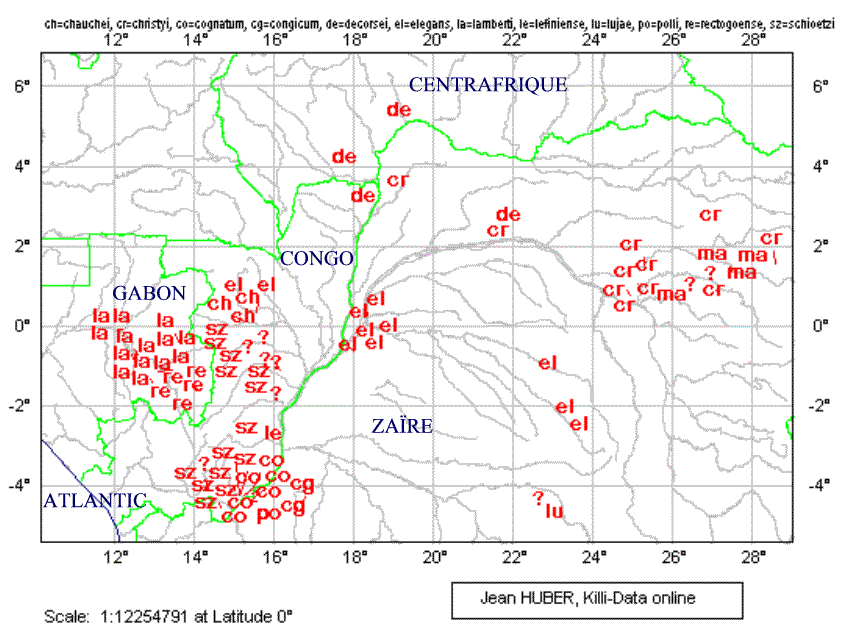
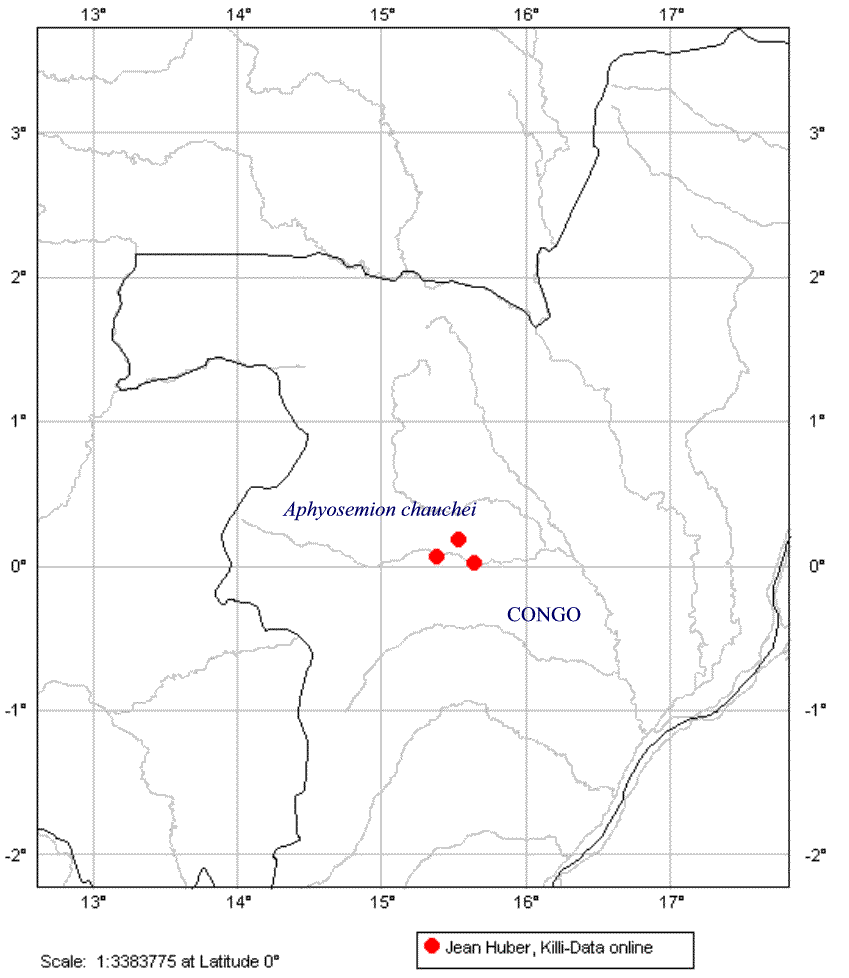
BIBLIOGRAPHIC INDEX (historical order): chauchei A.
Huber, J.H. & J.J. Scheel. 1981. Revue systématique de la Superespèce Aphyosemion elegans. Descriptions de A. chauchei et A. schioetzi n. sp. {Rev. fr. Aquariol. Herpétol., 8: 33-42.} : @Aphyosemion chauchei/Eco/Gen
Huber, J.H. 1982a. Rapport de Synthèse sur l'Expédition au Congo (1978). Cyprinodontidés récoltés et Micropanchax silvestris, Synonyme de stictopleuron. {Rev. fr. Aquariol. Herpétol., 9: 1-12, 9 figs., tab., 5 maps.} : Sys/Dis
Woeltjes, T. 1983a. Die Untergattung Aphyosemion. {D.K.G. (Deutsche Killifisch Gem.) J., 15 (1): 1-16, figs., map.} : Sys/Dis
Wagner, R. 1996. Meine Erfahrungen mit Aphyosemion chauchei "Masepe". {D.K.G. (Deutsche Killifisch Gem.) J., 28 (1): 7-9, figs., map.} : Aquar/Pat/Dis
Read the page of contents and legends in the Data-Base, now ? Click HERE.
Aquarists ! You are preparing an aquarium article on a specific Killifish, or you are just interested in a single species or genus for your private use and would like to get a copy of the corresponding file in the Data Base ?
Just ask, it's free. Fill in the GRATUITY form with the species or genus name and pledge to QUOTE the website and the concerned page in your article !
